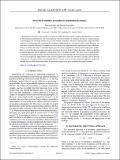Structural stability of nonlinear population dynamics
Author(s)
Cenci, Simone; Saavedra Sanchez, Serguei
DownloadPhysRevE.97.012401.pdf (1.033Mb)
PUBLISHER_POLICY
Publisher Policy
Article is made available in accordance with the publisher's policy and may be subject to US copyright law. Please refer to the publisher's site for terms of use.
Terms of use
Metadata
Show full item recordAbstract
In population dynamics, the concept of structural stability has been used to quantify the tolerance of a system to environmental perturbations. Yet, measuring the structural stability of nonlinear dynamical systems remains a challenging task. Focusing on the classic Lotka-Volterra dynamics, because of the linearity of the functional response, it has been possible to measure the conditions compatible with a structurally stable system. However, the functional response of biological communities is not always well approximated by deterministic linear functions. Thus, it is unclear the extent to which this linear approach can be generalized to other population dynamics models. Here, we show that the same approach used to investigate the classic Lotka-Volterra dynamics, which is called the structural approach, can be applied to a much larger class of nonlinear models. This class covers a large number of nonlinear functional responses that have been intensively investigated both theoretically and experimentally. We also investigate the applicability of the structural approach to stochastic dynamical systems and we provide a measure of structural stability for finite populations. Overall, we show that the structural approach can provide reliable and tractable information about the qualitative behavior of many nonlinear dynamical systems.
Date issued
2018-01Department
Massachusetts Institute of Technology. Department of Civil and Environmental EngineeringJournal
Physical Review E
Publisher
American Physical Society (APS)
Citation
Cenci, Simone, and Serguei Saavedra. “Structural Stability of Nonlinear Population Dynamics.” Physical Review E 97, 1 (January 2018): 012401 © 2018 American Physical Society
Version: Final published version
ISSN
2470-0045
2470-0053